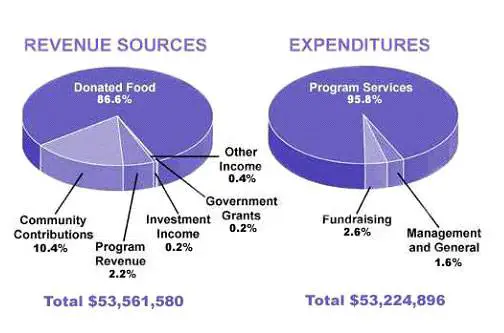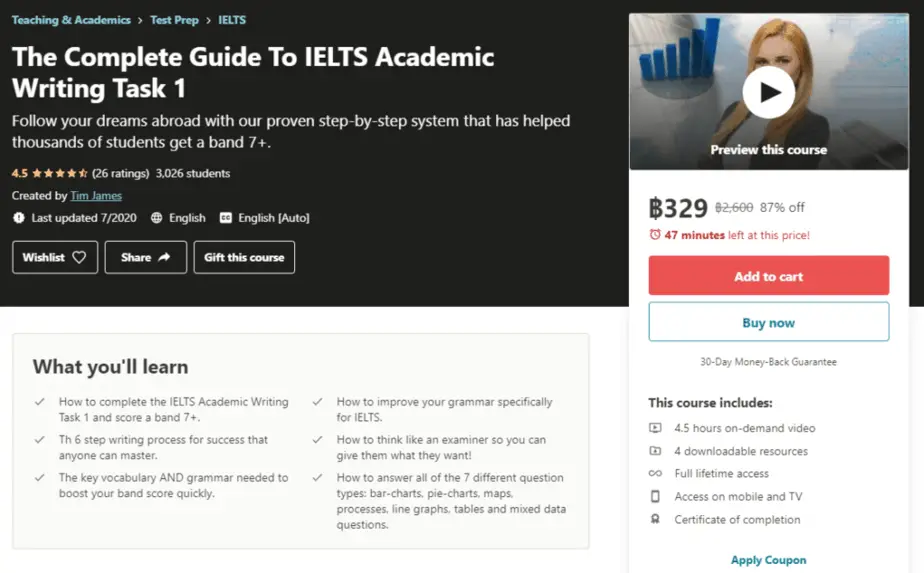The online ESL industry is set to be worth $2.7 billion by 2022 and exam preparation classes are expected to form a large part of that. The International English Language Testing System (IELTS) in particular, has over 3 million test takers per year so the opportunity is clearly there for entrepreneurial IELTS teachers to offer their services online (source) . But, how do you teach IELTS online?
To teach IELTS online you need to have a strong knowledge of each part of the test and of the band marking criteria. You need to be competent enough with technology to diagnose areas of a candidate’s weakness and deliver a series of activities to improve these using an online platform.
As a former IELTS speaking examiner and teacher of IELTS of over a decade I am going to try and talk you through how to teach IELTS online step by step. We are going to look at diagnosing students’ needs, the teaching process, where to find online IELTS students, and useful technology for teaching IELTS online, so strap yourself in, bookmark this page and let’s get started!
How To Become An Online IELTS Tutor
- Understand IELTS
- Find online IELTS students
- Conduct online lessons
- Reflect and improve
Let’s put some flesh on the bones now as there is quite a lot to it.
Step 1: Understand IELTS
It is imperative that you are very familiar with each part of the test so if you are new to the test then I recommend that you actually do the test. Get a copy of a past paper from here and then do the test under exam conditions and time pressure.
This will give you great insights into what the students are going through and you will probably be surprised at just how tricky certain sections are. Now, imagine how it must feel to try and do this in your second language. Assess your own performance using the IELTS band marking criteria and work out your overall band score.
If you are a native speaker you should be scoring band nines for the speaking test but you may slip up in the reading, writing and listening tests because there is a certain amount of exam technique and strategy required to get band nines and without having done the test before you might struggle a touch.
After doing this you will have a good idea about the test, next, you need to mug up on exam techniques and strategies so that you can actually demonstrate them and pass them on to your students.
A good place to start is with The Official Cambridge Guide to IELTS Student’s Book. Get a copy and use it to discover tips and strategies and just so you have a reliable book to refer to if a student ever asks you a question that you are not sure of the answer to.
Please be aware that some websites portraying themselves as IELTS experts actually provide incorrect information and practice questions that do not follow the correct structure so be wary of these and only use questions from the owners of the IELTS test, that is: IDP, British Council, and Cambridge English.

Step 2: Where To Get Online IELTS students
Now you are familiar with the test and have some techniques and strategies to share with students, it is time to actually find some students online to teach!
There are three main ways to do this:
Create A Teacher Profile Type Websites
These are sites where teachers create their own profile outlining the experience, credentials and what they are offering in terms of lesson types and prices.
In your profile you should be clearly stating that you are offering specialist IELTS lessons and what experience/qualifications you have to back this up.
Potential students browsing the site look through the profiles until they find a teacher that seems a good match for their needs. They can then book a trial lesson with you which they pay a small fee for and then you get to meet them and teach them for 20 minutes.
After this the student will book lessons with you or not depending on how they feel. Competition is often fierce on these websites so you really need to sell yourself well.
Eventually, however, the student feedback on your lessons presuming it is positive will be your main selling point.
Where can you go to do this?
Well, italki.com and Preply.com are the most well known websites that operate in this fashion but there are plenty more you will find with searching. Some are more picky about who they allow to create a profile on their site but if you spruce your CV up a bit it shouldn’t be too much of a barrier.
Here’s a full list of where to find IELTS students in this manner:

If you don’t already have some kind of TEFL/ESL certificate it may be worth your time getting either an online one, or preferably, a real life face to face teaching certificate, such as a CELTA.
This would really enhance your ability to get listed on these sites and give you more confidence if you are relatively new to teaching.
Whilst these types of websites are great for getting started and finding students for you competition is very high which as a consequence often drives the rate you can charge down.
However, do not despair, you are specialising in teaching IELTS and this is not a skill that a massive amount of teachers have unlike general conversation classes.
You might like: Can You Teach IELTS Without A Certificate?
Personally, being a former IELTS examiner I would not be interested in taking IELTS students for much less than $40/hour. However, if you are new to teaching IELTS online then I would start at $20/hour and then price yourself up as your reputation and confidence build.
Be warned though, that you may well have to do some lesson preparation for IELTS lessons so when you think about your hourly rate take that into consideration.
For example, there is no preparation needed for conversation classes, just show up and talk, however, you need to have the correct type of material ready and a clear lesson plan in order to make sure you are offering value for money when teaching IELTS.
Online IELTS School Jobs
There are online language schools that offer ESL lessons and there are also the standard language schools that have begun offering IELTS lessons online. Whilst searching around the internet I did not find these as easy to track down as I thought they would be but I am told they are out there.
These work in much the same way as a traditional language school. Therefore, there is likely to be a recruitment process to go through which may involve a demonstration lesson and interview.
The positives of working for a language school are that you will have colleagues to share ideas with.
Online teaching can be quite a lonely experience but if you have colleagues which you chat with and offer support then it can make a considerable difference to your morale and motivation levels.
There is more likely to be some form of quality control when working for these types of companies so you can expect to have more lesson observations and have your student feedback scrutinised.
The good news is that you should be provided with a decent supply of material to teach with and this can save you a good deal of time and make your life a lot easier.

Offer Freelance IELTS Lessons And/Or Courses
This can be a great way to start if you already have a network of students to work with. Perhaps you have a job in a school or university with students interested in studying IELTS.
Just make sure your school principal or director of studies is okay with this if you are till working there but if you are leaving employment with them entirely then you are good to go.
Try putting business cards/leaflets on notice boards in universities or cafes frequented by university students, sounds old school but works!
If you can get a foothold and reputation within a certain area as the ‘go to guy’ for IELTS then you may well find word of mouth marketing is enough to get you started and keep you going, this is the ideal scenario as marketing costs will be low.
If you are starting from zero then you may need to do some online advertising. You can try Craigslist, Facebook ads, Google Adwords. However, there is a learning curve with advertising networks such as these, therefore you may end up spending more money than you are earning per client!
Finally, you could even create your own IELTS course and try to sell it on platforms, such as Udemy. In my experience though this isn’t going to get you anywhere near a full time income. You can check out an IELTS course I created here.

That said, again with a lot of time and effort you could put something together as professional as this guy. He charges between $300-$500 for his course and coaching/checking services.
Although that sounds expensive students are getting a lot of individual attention for that price which must mean that his actual hourly rate is not as great as you might think for the owner and team.
Also, the owner is very good at marketing to prospects offering lots of free material and a strong email marketing campaign, not everyone would want to put this time and effort in. I’ve no idea what his overall take home salary must be but if you have marketing skills you could go down this route.
Lack of marketing skills is the main reason people don’t pursue this freelance method for long. Learning how to market yourself is beyond many people and it takes time to see results which can be frustrating.
However, it can be done if you are willing to stick at for more than just a few months. Eventually you could build your own brand and even your own courses. Take a look also at what this guy has done for inspiration: theIELTSteacher.com
Finally, don’t forget that a lot of IELTS candidates just want to have their writing checked so you could also offer an online IELTS essay checking service and/or demo speaking interviews, these seem to be quite popular as well.
Step 3: My Online IELTS Teaching Process
So, let’s assume now that you have gained some students to teach IELTS to using one or more of the above methods. What are you going to do with them. Here is what I do:
Identify Student’s Needs
Find out what their needs are. This includes key information such as:
- Have they booked their IELTS test yet? If so, when is it?
- Have they taken the test before? If so, what band did they get?
- How much time are they willing to put into lessons with you and preparing on their own?
- What are their motivations for taking IELTS? Visa, university etcetera…
Complete A Diagnostic Test
After getting this information I will then want to do a diagnostic of their language ability. I will do a face to face full IELTS interview making notes of their strengths and weaknesses in relation to the band marking criteria.
For reading, writing, and listening components, I will ask them to supply me with a copy of a paper they have completed but they must have done the writing component under timed conditions.
From looking at all of these you can work out where their strengths and weaknesses are, but, I don’t mean ‘they need to improve their speaking’. I mean you need to know which parts of the test they are poor at and why.
For example, the candidate struggles to speak at length in part 2 of the test which is hindering their fluency and coherence band score. They also repeat a lot of the same linking words and phrases which are sometimes used inappropriately which is limiting their coherence and cohesion band score.
You can also see what question types they are bad at in the listening and reading sections of the test. You may find that they struggle with certain types of questions more than others.
For example, many students struggle with matching True/False/Not Given question types.

Devise A Specific Plan
Once you have identified these students’ areas of weakness and you know how long it is until they take the test next you can devise a study plan for them.
Typically, I will look to cover all of the quick fixes first. By this I mean there are some things that can be fixed in just one lesson, such as writing an essay in the correct academic format/layout for IELTS.
From doing this alone, I will normally have a list of around 6-10 lessons that I immediately have in mind that will make a direct impact on the candidates band score the next time they take the test.
Usually, when the candidate sees your plan they will be motivated to sign-up for your lessons. There are just not that many teachers out there that have the know-how and willingness to put something specific together for a student, but that is going to be your selling point.
If you have a student with many months before their test I would still start with this same approach, fixing as many things as you can over the first few lessons. Following that I would then follow a ore structured approach rolling through a variety of topics likely to come up in IELTS.
Purchasing a few IELTS exercise books will give you plenty of material to go at. I use these and these regularly. However, you could go with an all in one platform, such as off2class.com which has pre prepared lessons that you can simply run through with the students.
Teach Your Online IELTS Lessons
The actual lessons I conduct will relate strongly to the students needs. This will dictate which skill and which part of the exam and even which question types we will be focusing on.
Let’s take a look though at what an online IELTS lesson might look like in terms of layout and activity types.
I use Google docs for most student work. I clip sections of pdfs or websites and arrange them in the way I want adding specific instructions where I think they are necessary.
If I have not had time to put this together then I work directly from pdf documents and use the highlighting tools to draw students focus to the particular parts that I want.
When it is the students turn to do something I simply get them to share their screen with me and we can work that way.
I always create a master copy and a copy for the student so there is a blank one available for a future student to make use of.
An Example Online IELTS Reading Lesson
Pre Reading task: skim reading of the text to be read and basic discussion on what it is about.
Teach question type strategy: I will use past IELTS papers and just screen share what I am looking at so they can follow along and show a student exactly how to do those troublesome question types step by step. I have a cheat sheet with all the steps written out here if you want to take a look.
Student talk through using the strategy (not time pressure): Once I have shown a student how to do it I will then ask the student to do another question and talk through what they are doing as they do it thus ensuring they follow the strategy and helping the process to become more memorable for them.
Student independently uses strategy (no time pressure): Now give the student another fresh question for them to have a go at but focus on them following the strategy rather than time.
Student independently uses strategy (time pressure): Introduce some time pressure this time pressure on another fresh question but allow.
Feedback/discussion: At this point towards the end of the lesson discuss how they find the strategy and what they might like to change in order for it to work/make sense better to them.
As they are learning the new strategy I do not put them under any time pressure, we just go through it step by step and it takes as long as it takes.
An Example Online IELTS Writing Lesson
Question sort: have a collection of real IELTS essays prepared and go through them discussing what types of essay questions they are: discussion, discussion and opinion, opinion, or two part question types.
Mode essay breakdown: Teach the correct layout for one essay style: Choose an essay type that you know they struggle with from their diagnostic test and show them a model answer for this question type.
Get the student to label what the different paragraphs of the essay are and identify how each paragraph is structured. If you are not sure about this yourself then take a look here for ideas.
Con-construct essay: Choose a question to try of the same essay type and get the student to write it but you talk everything through with them first. Question them about the best word choice, sentence type, sentence purpose and note spelling mistakes which can be used in future starter or plenaries.
Independent construction: Set an essay task for homework under time pressure and see what they can produce.
Feedback: There is no point ging through this if timely feedback is not provided. You should be providing an estimated band score backed up by your reasoning for each criteria and provide strategies for improving in each of the bands.
If your student(s) is/are making the same types of grammatical errors over and over then you might want to start future lessons with straight grammar activities taken from a book. You can scan these onto your computer and share them with your student(s).
You can rotate this lesson through different question types and topics and it works well for task 1 questions as well. You will get plenty of leverage out of this approach so you should never have to worry about what or how you are going to teach online IELTS writing.

An Example Online IELTS Speaking Lesson
Pronunciation based starter: Choose a selection of words which you feel will be relevant to the questions you have planned for today’s lesson, say around twenty.
Read out each word using either the correct or incorrect intonation. The student has to decide if it was correct or not and say it back to you correctly in a sentence so you can check they have the meaning of the word correct.
You should also pick them up on sound linking/chunking during this section as this heavily impacts a students pronunciation score.
Of course there is no end of starter activities that you could do: anything from straight small talk, news chat, vocabulary meaning matching, idiom meaning matching and so on, or just a straight set of IELTS speaking part 1 questions.
Model a new strategy: From the diagnostic you should know what areas the students struggle with most so introduce one of your strategies to help improve their performance here.
For example, you could model use of a variety of different linking words or phrases in a speaking part 2 speaking task. You could demonstrate how to structure answers on part 3 of the test, or you could teach them simple techniques for part 1 of the test.
If you don’t know any then take a look at my IELT website here for ideas.
Student’s turn: Let the student have a go with your new technique.
Feedback: provide details feedback on the students performance particularly in relation to what you were asking them to do. Repeat the same question, similar or completely different questions in order to give the student the opportunity to improve their performance. Repeat this for the remainder of the lesson.
I like to make a note of exactly what the student has improved on at the end of the lesson so that we can recap it and do it again at the start of the next lesson. In this way students can feel the progress from lesson to lesson better and it makes it more likely to stick in their memory.
I still use a google doc for speaking lessons and have all the questions we’ve gone through left on there so that we can track progress lesson to lesson.
An Example Online IELTS Listening Lesson
Now, I’ll be honest listening lessons are not my favourite lesson type to teach and I would heavily encourage students to go through practise tests on their own marking answers for themselves.
Afterwards they can use the transcript to work out where the answers were and how and why they missed it when they were listening. They can listen multiple times until they finally ‘get it’.
If your students are desperate for listening lessons, though, I would approach it something like this:
Starter: Listen to a short news clip a couple of times and quiz the student on the overall meaning. Get the student to play the clip on their device rather than trying to play it at your end through skype – that damages sound quality.
I let the student play it twice and ask them to either explain whatever numbers were mentioned in the clip, and quiz them on the overall situation and meaning of the clip.
Main activity: Now go through one of the listening strategies for a question type they struggle with and play a section of a listening test with those question types.
Encourage them to use the strategy supplied and see if they can get it right.
If not play it again, slow it down, ask questions/give hints as the recording is playing to try and draw it out of them. If they still cannot then let them stop the recording directly after the answer is given.
Keep rewinding and playing this section over and over again until they finally hear and understand the answer.
If they are still struggling let them read the transcript for that section of the test. Let them try and work out the answer by reading it and also try to figure out how/why they could not get the correct answer originally.
A big part of the test is understanding how the recording will try and confuse you with the use of synonyms, distractors and conjunctions of contrast.
Once these are pointed out to students on multiple occasions then they are much more likely to come up with the correct answers so make this a constant part of what you do with the students.
Play the recording again one more time and let them hear it and try and understand it fully this last time.
You can do as many sections as your lesson time allows.

An Example Multi Skill Online IELTS Lesson
It often works well, however, to combine an input skill, such as listening, reading with an output skill speaking or writing. This works especially well if you pre teach the vocabulary needed first.
For example, you might do a crossword activity that utilizes the vocabulary to be used in the remainder of the lesson.
You might then jump into a listening exercise focused around a typical IELTS topic such as education and tackle some controversial issues such as all students should be made to learn three languages, or all students need to study until they are eighteen.
Discuss some of the issues raised in the style of an IELTS speaking part 3 test. Make a note of students’ mistakes and correct them after the conversation. You may then choose to redo the conversation or at least parts of it with the student making the corrections.
After this you could go through the layout of an IELTS discussion style essay. You could then plan the easy together and let the student complete the essay in their own time for homework.
As you can see there is plenty of scope for variety in a multi-skill online IELTS lesson. However, I strongly suggest the threes steps:
- Pre teach vocabulary
- Complete input exercises (reading and listening)
- Complete output exercises (speaking and writing)
Using this approach, your students will feel as though they are getting a thorough workout of their IELTS skills but not by simpy doing endless past papers.
Finally, remember though, the key to their improvement is going to be your expert feedback. The quicker and more specific you can be with your feedback the greater the improvements tend to be. This is really important especially, if we are relying on word of mouth marketing for our future clients.
4. Reflect And Improve Upon Your Online IELTS Lessons and Marketing
The final part of teaching IELTS lessons online is to reflect on how they have gone. What has worked well, what has not and figure out how and why you can do it better.
If you are using an online platform then the students will usually get the opportunity to leave you feedback and you should pay close attention to these comments and act on them if needs be to improve customer retention.
Don’t overlook how much you have spent on your marketing costs to gain each new student. You need to constantly find cheaper and more efficient ways to gain new online IELTS students if you are going to make this work long term.
There we go, not quite in a nutshell but anyway that’s my guide to teaching IELTS online, good luck!
You might also want to read How To Teach English Online

